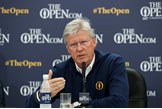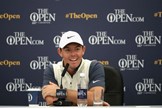Martin Slumbers explains why the R&A have been testing drivers at The Open
Published: Last updated:
Martin Slumbers explains why the R&A have been testing drivers from 30 players at the Open; Rory McIlroy weighs in
When players arrived at the 147th Open, thirty had received letters from The R&A requesting their drivers for testing at the equipment standards office at Carnoustie’s practice ground by 5pm on Tuesday.
The list of randomly selected players included seven major champions, who’s clubs then had to pass a COR test (coefficient of restitution) – which measures the transfer of energy from driver to ball at the moment of impact.
The R&A had sent advance notice that some competitors may have their drivers tested, and 30 players were then selected to test that their drivers conformed to CT ‘Characteristic Time’ limits. It’s the first request of its kind on the PGA and European Tour, although a similar test was conducted on the Japanese Tour earlier this year.
The news originally came from a Golf Channel report, and R&A Chief Executive Martin Slumbers was then quizzed during a press conference on Wednesday about the reasoning behind the test.
While there has been a testing facility at previous Open’s for players and manufacturers to come to on a voluntary basis, he explained that this year they decided to randomly select player’s drivers straight from their bags as they continue to work on the new rules.
“Well, we’ve always had an equipment test capability down on the range, certainly since I’ve been involved in The Open,” Slumbers said. “It’s been an option for players or the manufacturers to take their equipment in and have it tested.
“We take our governance role very seriously, not just on the rules of golf and amateur status, but also equipment standards, and we felt it was an appropriate next step to more actively seek to test players’ drivers straight out of the bag.”
But why now?
The R&A and USGA published their 2017 driving distance report back in March, which confirmed what we had all known – professional golfers are hitting the ball further than ever before on each of the men’s tours.
The R&A had said the distances had ‘caused us and our colleagues at the USGA serious concern’, and that they intended to ‘bring forward proposals designed to improve procedures for the approval of new products.’
And now, Slumbers says there has been an ongoing discussion about the CT limits on a driver, and what happens to it when it wears – something they have been considering for a while.
“Well, one of the discussions that goes on in the equipment world is what happens to the CT or the driver, as it wears,” Slumbers continued.
“That’s some of the questions that we’ve been working on in the new rule book. So as it wears, they generally get nearer to the CT limit, and we wanted to make sure that we didn’t have drivers going out there above the CT limit.”
As drivers get older, they can naturally become weaker, and that in turn can raise the CT limit above the conforming level set by golf’s governing bodies. This will make ball speeds increase as the clubface responds quicker to the ball at the moment of impact – giving players an advantage over their competitors.
“It was a request to players, and I think many of you underestimate, we have a very good relationship with our players, and it’s a very collaborative relationship, and we had absolutely no problems with the players coming and were interested in what we’re doing. A lot of them actually wanted to know how does the test work, and what is it really testing for?”
He was however quick to point out that this testing is not a direct response to a spike in driving distance this year, stating instead that it was more about making sure there aren’t any non-conforming clubs being used at Carnoustie.
“No, it wasn’t driven by the spike at all,” he said. “It’s driven by us just trying to keep moving the Championship forward and making it more complete and making sure that there is a service provided to ensure that the players are going out there with clubs that are conforming.”
Rory McIlroy weighs in on the topic
Rory McIlroy was understanding of the tests when asked in his own press conference on Wednesday despite not being one of the randomly selected players, although he did point out he noticed a bit of a trend with who had been chosen.
“I wasn’t selected,” he said. “I did have a look at the board and see who was selected. I think there was one manufacturer that was singled out a bit more than anyone else.”
When pressed about who he felt was being singled out, he confirmed that there were more players chosen using TaylorMade drivers than any other.
“The one that I’m using. And I don’t know — I think — it’s not — you know, a manufacturer is always going to try and find ways to get around the regulations. It’s a bit of an arms race. I don’t know what his reasons are or what Martin said, so I don’t — I understand why they’re testing equipment.
“If there is some drivers out there that have went a little bit over the limit, then, obviously, guys shouldn’t be playing them. I think the manufacturers are smart enough to know not to try to push it too much. I’d be very surprised if they found anything this week.”
How is a driver usually tested?
When a new driver is created by a manufacturer, the head is sent to both the R&A and USGA, and they will then conduct a test to make sure the CT (which refers to the spring-like effect between the clubface and ball) conforms to their specifications.
The R&A and USGA measure this time in microseconds, and in simple terms the test involves measuring how quickly the face responds or reacts/ bounces back when hit by a small hammer-like pendulum testing apparatus.
Sometimes, they will ask for extra samples if they feel a driver head is too close to the limit, but as TG’s equipment editor Simon Daddow explains – the limits for manufacturers aren’t quite as black and white as you might think.
“There isn’t just a set limit manufacturers are given,” he said. “Manufacturing isn’t perfect and it’s impossible to guarantee each driver will have the same limit, so instead they are given a ‘tolerance’ that they have to conform to. It’s the reason some drivers are hotter than others, as the CT limit varies slightly between different heads, and it means the chances are that some drivers out on Tour could be close to or over the CT limit but inside the tolerance level.
“Normally, drivers would have this initial testing and that would likely be it – they wouldn’t be tested further at every event unless a player had requested they do so.
“What seems to have changed this week is that the R&A are selecting people to be tested randomly, which has never been the case before, and it shows they are starting to enforce their own rules in a way they have never done before.”
What next?
It’s unclear whether this will become the norm, but Slumbers has been clear about his concerns over the impact of technology on distance, and is keen to make sure that a balance remains between the two.
“This time last year, I made a comment that we were waiting to see what the full year distance numbers look like, but I expressed in this room that we were concerned where the preliminary numbers were going, and that our concern was based upon the balance between skill and technology and whether the balance between skill and technology for the recreational game and the elite game was appropriate.
“And that’s the concern that I outlined a year ago. We still believe that, what we are looking at is not just where we are today, but very much where are we going and where the game’s going 20 years from now in terms of that balance between skill and technology?
“Golf is a game of skill, and long may it remain being a game of skill. We started the distance report three years ago, driven entirely because I believe that we needed to get transparency, and there was too much Chinese whispers around what data were we looking at, so we published it. And it was fascinating seeing the results and the comments on the published data.
“When we published it at the beginning of this year, we were very clear saying that the concern that I had alluded to a year ago was real, and with the USGA, we said that we would now want to start an open and constructive dialogue around the hitting distance.
“We’ve started that process. We’ve talked to a number of people. From my perspective, I’m in listen mode. I’m listening. I’m talking to lots of constituents in the industry. I’m getting their perspective around what they think about how far the golf ball is being hit and where it is going, and I am absolutely of the view that I will continue listening and that whatever the outcome of this work over the next year or so will be done collaboratively and as an industry, and we need to work together and talk together and make sure that we do the right thing for this wonderful game that not only employs all of us, but actually that we all love.”


